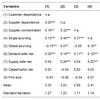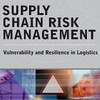 Today’s journal article is from Germany. In An empirical investigation into supply chain vulnerability Stephan M. Wagner and Christoph Bode examine the relationship between a selection of supply chain characteristics and supply chain risks, and provide an empirical investigation into the supply chain vulnerability construct, based on a surveys and interviews of close to 5000 top-level executives.
Today’s journal article is from Germany. In An empirical investigation into supply chain vulnerability Stephan M. Wagner and Christoph Bode examine the relationship between a selection of supply chain characteristics and supply chain risks, and provide an empirical investigation into the supply chain vulnerability construct, based on a surveys and interviews of close to 5000 top-level executives.
First they set out to define supply chain risk, equating it with the detriment of supply chain disruption, that is realized harm or loss. Interestingly, supply chain disruption is seen as a cause of supply chain risk, and not as a kind of risk per se.
Looking at supply chain vulnerability, they posit that supply chain vulnerability is a function of certain supply chain characteristics and that the loss a firm incurs is a result of of its supply chain vulnerability to a given supply chain disruption. In essence, disruption > risk > vulnerability.
As drivers of supply chain vulnerability they focus on 1) supply-side risk and 2) demand-side risk, as well as 3) catastrophic risk, listing a) customer dependence and b) supplier dependence, d) supplier concentration and d) single sourcing and e) global sourcing as sources of risk.
In a) the firm is on one hand dependent on its source as a supplier, but should b) not forget that at the same time its customers are equally dependent on it as their supplier. Thirdly, c) and d) imply that the advantage of a too close relationship with a small supplier base is offset by the disadvantage of not being able to switch to contingency suppliers in a disruptive situation. Lastly, e) implies that global sourcing contributes to the structural complexity of the chain, hence increasing uncertainty and decreasing visibility and transparency.
The hypothesis to be tested is that the five (a-e) drivers of supply chain vulnerability are positively related to the three (1-3) supply chain risk sources.
The results show that customer dependence is positively related to demand-side risk as in volatile demand or customer dissatisfaction. Risk derived from supply side risk sources is elevated by supplier dependence as in poor quality, product shortages, and poor supplier logistics. The latter is further elevated by global sourcing, adding long lead times and more complex problems the further upstream in supply chain disruptions occur. Catastrophic risks, obviously, are not very prevalent in Germany, but the research shows that supplier dependence decreases the risk exposure to catastrophes, provided sufficient cooperation at the supply base.
In conclusion, the article has a substantial bibliography, nothing amiss there. Add to that a clear structure,and clear language, this is a very interesting and rewarding read.
Reference
WAGNER, S., & BODE, C. (2006). An empirical investigation into supply chain vulnerability Journal of Purchasing and Supply Management, 12 (6), 301-312 DOI: 10.1016/j.pursup.2007.01.004
Author links
- ethz.ch: Prof. Dr. Stephan M. Wagner
- ethz.de: Dr. Christoph Bode
Related
- husdal.com: Book Review: Supply Chain Risk












